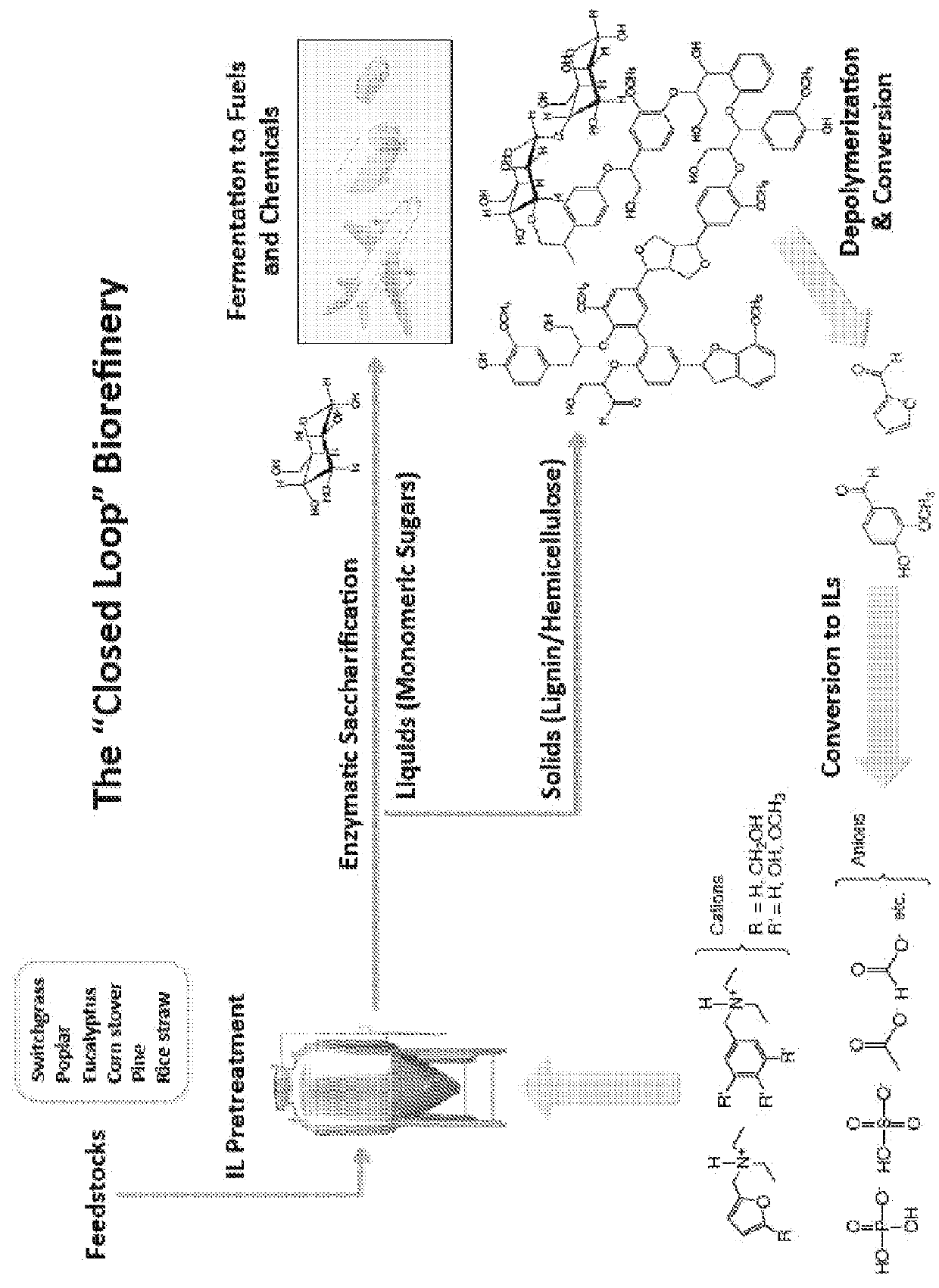Synthesis of novel ionic liquids from lignin-derived compounds
a technology of lignin-derived compounds and ionic liquids, which is applied in the direction of dissolving, non-aqueous electrolytes, organic electrolyte cells, etc., can solve the problems of lignocellulosic biomass recalcitrant nature, the economic viability of this technology is limited, and the cost of ionic liquids is high
- Summary
- Abstract
- Description
- Claims
- Application Information
AI Technical Summary
Benefits of technology
Problems solved by technology
Method used
Image
Examples
example 1
Production of Ionic Liquids from Lignin
[0140]a. Depolymerization
[0141]Lignin is depolymerized by methods known in the art (See. e.g., Pandey, 2011). Briefly, 40 g of lignin is contacted with 80 g of CuSO4.5H2O and 70 g of NaOH in 400 g of H2O for 5 hours at 160° C. to yield low molecular weight (e.g., monomer, dimer, trimer, etc.) aromatic aldehydes (Pearl, 1942).
[0142]b. Reductive Amination
[0143]Aromatic aldehydes are converted to diethylamines via reductive amination by methods known in the art (See, e.g., Abdel-Magid, 1996). Briefly, 12.9 mL (1.2 equiv.) of diethylamine is added to a stirred solution of 10 g of the aldehydes obtained in step (a) in 260 mL 1,2-dichloroethane or acetonitrile. The mixture is stirred for 5 min. Optionally, glacial acetic acid (1 equiv.) is added to facilitate conversion of the amino-alcohol adduct to the iminium species, which is reduced in the next step. The mixture is cooled to 0° C. Sodium triacetoxyborohydride (30.9 g, 1.4 equiv.) is added portio...
example 2
Reductive Amination of Lignoaldehydes
a. N-Ethyl-N-(furan-2-ylmethyl)ethanamine (1)
[0146]
[0147]General Protocol (Abdel-Magid, (1996):
[0148]To a stirred solution of furfural (10.0 g, 1 equiv.) in 1,2-dichloroethane or acetonitrile (260 mL) is added diethylamine (12.9 mL, 1.2 equiv.) and the mixture is stirred for 5 min. Optionally, glacial acetic acid (1 equiv.) can be added to facilitate the conversion of the amino-alcohol adduct to the iminium species, which is reduced in the next step. The mixture is cooled to 0° C. Sodium triacetoxyborohydride (30.9 g, 1.4 equiv.) is added portion-wise, and the mixture is stirred at room temperature overnight. The solution is quenched by adding aq. 1M HCl and the amine product is thus drawn in the aqueous phase. The organic impurities are removed by washing with CH2Cl2. The pH of the aqueous phase is raised to approximately 10.3 by addition of 1M NaOH, and the product is extracted with EtOAc (2×). The combined organic layers are dried over MgSO4, ...
example 3
Formation of the Ionic Liquids Via Protonation
a. N-Ethyl-N-(furan-2-ylmethyl)ethanamine, H2SO4 salt (1a)
[0165]
[0166]General Protocol:
[0167]To a stirred solution of 1 (10.0 g, 1 equiv.) in MeOH (45 mL) at 0° C. is added H2SO4 (2 M in MeOH, 32.6 mL, 1 equiv.). Methanol is evaporated under vacuum and the ionic liquid 1a is obtained in quantitative yield. All the hydrogen sulfate ionic liquids described below are prepared by this method. 1H NMR (DMSO-d6) 1.25 (t, 6H), 3.08 (q, 4H), 4.43 (s, 2H), 6.58 (s, 1H) 6.78 (s, 1H) 7.85 (s, 1H). 13C NMR (DMSO-d6) 8.8 (2C), 46.8 (2C), 52.9, 111.2, 114.3, 144.0, 145.1.
b. N-Ethyl-N-(furan-2-ylmethyl)ethanamine, H3PO4 salt (1b)
[0168]
[0169]General Protocol:
[0170]To a stirred solution of 1 (10.0 g, 1 equiv.) in MeOH (45 mL) at 0° C. is added H3PO4 (2 M in MeOH, 32.6 mL. 1 equiv.). Methanol is evaporated under vacuum and the ionic liquid 1b is obtained in quantitative yield. All the dihydrogen phosphate ionic liquids described below are prepared by this ...
PUM
| Property | Measurement | Unit |
|---|---|---|
| Melting point | aaaaa | aaaaa |
| Equivalent mass | aaaaa | aaaaa |
| Temperature | aaaaa | aaaaa |
Abstract
Description
Claims
Application Information
 Login to View More
Login to View More - R&D
- Intellectual Property
- Life Sciences
- Materials
- Tech Scout
- Unparalleled Data Quality
- Higher Quality Content
- 60% Fewer Hallucinations
Browse by: Latest US Patents, China's latest patents, Technical Efficacy Thesaurus, Application Domain, Technology Topic, Popular Technical Reports.
© 2025 PatSnap. All rights reserved.Legal|Privacy policy|Modern Slavery Act Transparency Statement|Sitemap|About US| Contact US: help@patsnap.com



